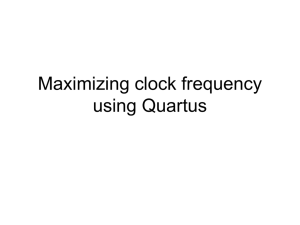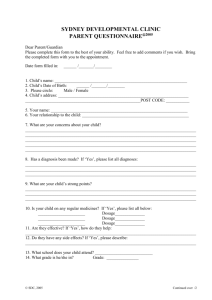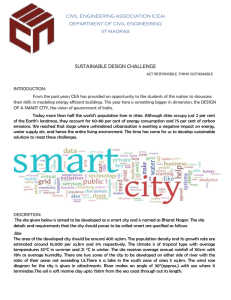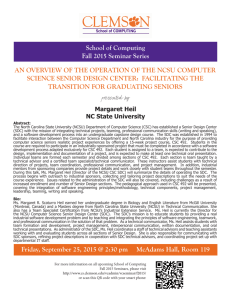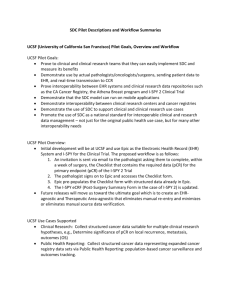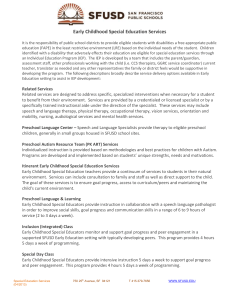Review: User Stories
advertisement
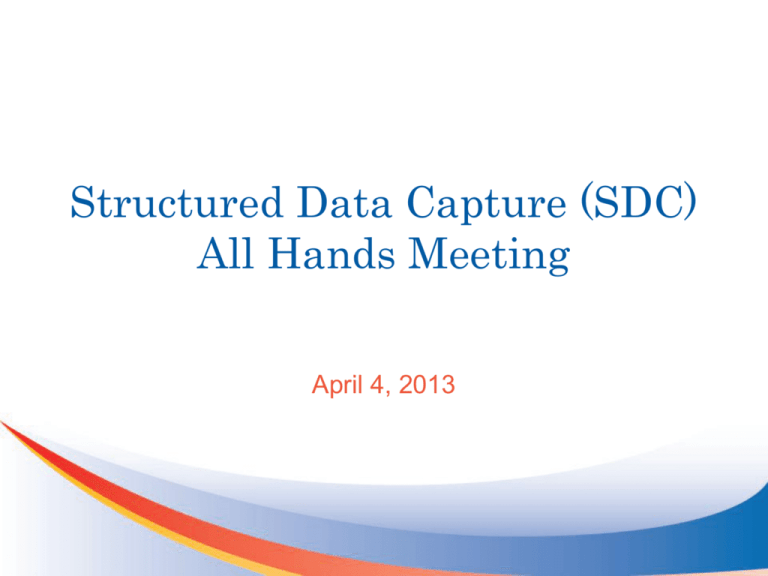
Structured Data Capture (SDC) All Hands Meeting April 4, 2013 Meeting Etiquette • • • • Remember: If you are not speaking, please keep your phone on mute Do not put your phone on hold. If you need to take a call, hang up and dial in again when finished with your other call o Hold = Elevator Music = frustrated speakers and participants This meeting is being recorded o Another reason to keep your phone on mute when not speaking Use the “Chat” feature for questions, comments and items you would like the moderator or other participants to know. From S&I Framework to Participants: o Send comments to All Panelists so they can be Hi everyone: remember to keep your addressed publically in the chat, or discussed in the phone on mute meeting (as appropriate). All Panelists 2 Agenda Topic Time Allotted Welcome and Announcements Meeting Reminders & Announcements Join the Initiative SDC Roadmap 10 minutes Use Case Timeline Review SDC Use Case Comments & Disposition Review Functional Requirements 40 minutes Next Steps / Homework 5 minutes Community Presentation: Aster-D Demonstration 30 minutes 3 Meeting Reminders & Announcements • Structured Data Capture (SDC) Initiative holds weekly community meetings on Thursdays at 3:25 pm EST. – Next meeting is scheduled for April 11, 2013 from 3:25 pm – 5:00 pm Eastern. – Next meeting will focus on the Candidate Standards List – See the SDC Wiki Page for meeting information – http://wiki.siframework.org/Structured+Data+Capture+Initiative Please check the meeting schedule weekly as the meeting link and call in numbers will change. 4 All Hands Meetings Extended • Spring Concert Series Continues – Demonstrations by SDC relevant community members and stakeholders • All Hands Meetings has been extended by ½ hour to accommodate these presentations. – 3:25 to 4:30 pm Eastern: All Hands Community Working Meeting – 4:30 to 5:00 pm Eastern: Scheduled Presentation • Today’s Presentation – ASTER-D • Upcoming Presentations – 11APR13: Candidate Standards Presentation (confirmed) Join the SDC Initiative • To join the Structured Data Capture (SDC) Initiative, go here: http://wiki.siframework.org/Join+Structured+Data+Capture+Initiative. • Joining the initiative ensures that you are included on initiative communications and announcements. You may join as an Interested Party or a Committed Member. (More information about these two options is on the Join page.) • Thank you! Your commitment and participation are critical to our success. Structured Data Capture (SDC) Initiative: Proposed Standards & Harmonization WGs and Timeline Dec ‘12 Jan ‘13 Feb ‘13 Mar ‘13 Apr ‘13 May ‘13 Jun ‘13 Jul ‘13 Initiative Kick Off: 1/23/13 Pilots & Evaluation after September Use Case & Functional Requirements Pre-Planning Aug ‘13 Pre-Discovery Standards & Harmonization Sept ‘13 Pilots & Testing Evaluation SDC All-Hands WG Use Case WG Standards & Harmonization WG Form SWG - (1) CDE Standard - (2) Structure Standard Standards SWG - (3) EHR Interaction Standard - (4) Auto-populate standard Technical Work stream Common Formats SWG… AHRQ Lead Content Work stream PCOR Content SWG… NLM Lead Structured Data Capture Initiative Proposed Use Case & Functional Requirements Development Timeline Week Target Date All Hands WG Meeting Tasks 1 2/28 Use Case Kick-Off & UC Process Overview Introduce: Assumptions, Pre/Post Conditions - 3/7 2 3/14 User Stories, Pre/Post Conditions 3 3/21 User Stories, Actors & Roles 4 3/28 Base Flow, Activity Diagram 5 4/4 6 Homework due Tuesday COB Review: Charter content, Context Diagram, Assumptions Cancelled for HIMSS Finalize: Context Diagram, Assumptions Review: User Stories Finalize: Actors/Roles, Pre/Post Conditions Draft: User Stories Review: Actors & Roles, Pre/Post Conditions Review: User Stories Finalize: User Stories Review: Base Flow, Activity Diagram Functional Requirements Finalize: Base Flow, Activity Diagram Review: Functional Requirements 4/11 Functional Requirements, Sequence Diagram Review: Functional Requirements, Sequence Diagram Review: Functional Requirements, Sequence Diagram 7 4/18 Data Requirements Finalize: Functional Requirements, Sequence Diagram Review: Data Requirements, Risks, Issues, & Obstacles 8 4/25 Data Requirements, Risks, Issues, & Obstacles Review: Data Requirements, Risks, Issues, & Obstacles Review: Data Requirements, Risks, Issues, & Obstacles 9 5/2 Finalize: Data Requirements, Risks, Issues, & Obstacles 10 5/9 Full Review 11 5/16 End-to-End Review (5/10-5/20) 12 5/23 Consensus (5/24-5/29) FINAL CONSENSUS None End-to-End Review (5/10-5/20) End-to-End Review due 5/20 Cast consensus vote SDC Use Case Comments • See spreadsheet. SDC Use Case Functional Requirements • See word document. Next Steps • HOMEWORK – Provide comments to all posted content on wiki – http://wiki.siframework.org/Structured+Data+Capture+Use+Case+Comments • Next Work Group Meeting – Will focus on the Candidate Standards List – Thursday, April 11, 2013 from 3:30pm – 5:00pm Eastern • http://wiki.siframework.org/Structured+Data+Capture+Initiative • Reminder: All SDC Announcements, Meeting Schedules, Agendas, Minutes, References, Use Cases, and Project Charter are posted on the SDC Wiki page – http://wiki.siframework.org/Structured+Data+Capture+Initiative Community Presentation • Topic: ASTER-D * ASTER-D Project Overview and Demo * ASTER-D Team Project Sponsor: FDA CDRH - Terrie Reed; Director, Informatics - Leslie Tompkins; Informatics Team Project Contributors: Quintiles – Outcome - Dan Levy; Vice President, Information Technology - Tom Taylor; Sr. Project Manager Mercy - Joe Drozda; MD - Project Team includes: Paul Helmering, James Roach, Karen Call, Ben Graf, Pallavi Chandak, Mark Ramach Children’s National - Brian Jacobs; MD - Lorenzo Nicholson; Project Manager * ASTER-D Goals Increase the number and quality of device adverse event reports, currently being underreported, by streamlining the time it takes to complete and submit a 3500A form. The project also supports an FDA initiative to collect Unique Device Identifiers (UDI). The Adverse Spontaneous Triggered Events Reporting (ASTER) study demonstrated that facilitated, “triggered reporting” increased the number of adverse events reported by clinicians. CDRH is piloting ASTER-D to facilitate the use of hospital EHRs and Incident Reporting Systems to detect and automatically report select devices associated adverse events to the FDA. The creation of systems that facilitate triggered or automatic reporting of selected devicerelated adverse events via the EHR to the FDA as part of a clinician’s normal work flow is likely to increase the number and quality of adverse event reports, decrease under-reporting, and more regularly alert the FDA of potential device-related concerns. * * Source: Center for Devices and Radiological Health, U.S. Food and Drug Administration. Strengthening Our National System for Medical Device Postmarket Surveillance, (Sept. 2012). * ASTER-D Project Overview Method: Enable the 3500A form within an EHR / incident reporting system via RFD at a determined trigger to: a) Pre-populate appropriate data into the 3500A, reducing the data entry burden. b) Improve data quality by adding edit checks and warnings. Current Status: Mercy implemented an AE reporting interface with pre-population of data, including UDI, from their EHR and incident reporting systems. Outcome has developed a Safety Information Exchange (SIE), a set of cloud-based services, which host the 3500A form. RFD has been enabled to serve the form within Mercy’s interface. 3500A data are collected and transformed to the HL7 ICSR format for submission to FDA. Next Steps: Dry-run testing of Mercy. Incorporating Children's National into the project. 3-month data submission by each partner. Publication of final findings. 3500A to HL7 ISCR SDC & * ASTER-D Synergy SDC Use Case Model: SDC & ASTER-D Synergy * EHR (Form Filler) 1 Selects form/template 4 Form/Template Repository 2 Finds form/template External Data Repository 7 5 Extract, transform & load data by form/template Caches data Inputs data 3 Converts, populates and displays form 6 Stores/transmits data • A potential Adverse Event occurs. •Via RFD (Retrieve Form for Data Capture), the 3500A form is surfaced within the EHR (or other form filler). • After review of the AE, with the potential for manual entry of additional data, the completed AE is ready for submission to FDA. • A complete and approved 3500A form is transformed to HL7 ICSR and transmitted to the FDA’s eMDR (Electronic Medical Device Reporting). • The AE data are ultimately stored in MAUDE (Manufacturer and User Facility Device Experience Database). * ASTER-D Demo Q&A Thank You! Contact Information • For questions, please contact your support leads – – – – – Initiative Coordinator: Evelyn Gallego (evelyn.gallego@siframework.org) Project Manager: Jenny Brush (jenny.brush@esacinc.com) PM Support: Zachary May (zachary.may@esacinc.com) Use Case/Requirements Lead: Jennifer Sisto (jennifer.t.sisto@accenturefederal.com) Standards Development Lead: Caryn Just (caryn.k.just@accenturefederal.com)
![4/12/13 [Draft: Please share comments with CETL] Accessible](http://s3.studylib.net/store/data/008997901_1-e2f4a6179d61b85bc7203af0c6ffbe3c-300x300.png)
